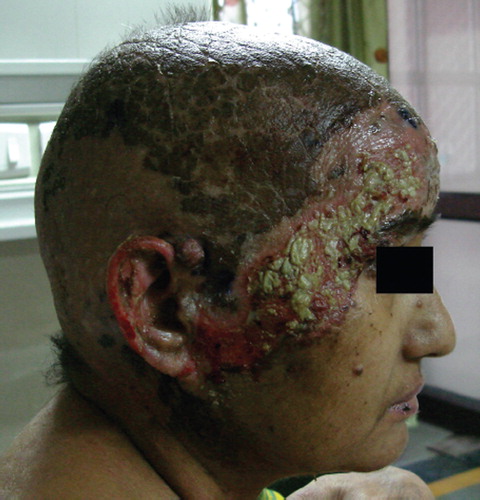To the Editor,
Antiepileptic drugs (AEDs) are an essential component of management of patients with primary or metastatic central nervous system (CNS) tumors presenting with seizure activity, with phenytoin being one of the commonest drugs employed in this scenario. A large majority of these patients also require use of systemic steroids and cranial radiotherapy for management of their symptoms. We present a patient with CNS-metastatic breast cancer, who developed a severe cutaneous reaction to a combination of the above modalities, in order to highlight the importance of identifying and anticipating this potentially fatal but preventable complication.
A 48-year-old postmenopausal lady presented to us with complaints of severe headache, vomiting, and two episodes of generalized tonic clonic seizures over one week. There was no history of focal neurological deficits. She was a known patient of right breast cancer T4bN1M0 (hormone receptor negative, HER-2/neu 3+) diagnosed two years previously and treated with modified radical mastectomy, six cycles of chemotherapy with CEF regime, chest wall irradiation and one year of adjuvant trastuzumab, and was on regular follow-up. Imaging suggested multiple brain metastases, and she was put on phenytoin 300 mg daily and medical decompression with steroids (dexamethasone 8 mg thrice daily) and diuretics. A week later, her general condition improved considerably, and she was considered for palliative cranial radiotherapy. A radiotherapy dose of 30 Gy was delivered to whole brain in 10 fractions over two weeks, with 6 MV photons and German helmet technique. Following completion of radiotherapy, we tapered the dose of dexamethasone by one-third every week. Ten days following completion of radiotherapy, she developed erythematous eruptions over her scalp, which later spread to her trunk and limbs. She developed grade 4 desquamation over her scalp and ear lobes, with haemorrhagic crusts. She also had grade 3 mucositis confined to the oral cavity and conjunctival congestion. Her vitals and temperature were within normal limits, with no evidence of organ dysfunction. A clinical diagnosis of Stevens-Johnson syndrome (SJS) was made. Phenytoin was discontinued, and sodium valproate was started instead. Intravenous fluid replacement, antibiotic dressing of the skin wounds and escalation of steroid dose (dexamethasone 8 mg thrice daily) resulted in rapid improvement of the skin lesions over a week. However, the scalp lesions persisted for another two weeks, before showing signs of healing ().
Figure 1. Lateral view of the patient showing extensive desquamation of the scalp and ear with intensification at the treatment borders of the German helmet portal, 10 days following diagnosis of Stevens-Johnson syndrome. The lip lesions are in healing phase.

Erythema multiforme major, SJS or toxic epidermal necrolysis (TEN) represent a spectrum of hypersensitivity reactions associated with use of antiepileptic drugs including phenytoin, phenobarbital, carbamazepine, valproate and lamotrigine, the incidence with phenytoin being as high as 15% for SJS and 2.4% for TEN, especially in the first eight weeks of use [Citation1,Citation2]. Concurrent use of radiation therapy has rarely been seen to produce intensification of these reactions in the radiotherapy treatment portals. Around 30 such cases have been described in the world literature. Ahmad and colleagues reviewed data on 27 patients with SJS-TEN appearing during or soon after cranial radiotherapy in patients with primary or metastatic CNS tumors. Extent and severity of skin lesions were unrelated to age, gender, phenytoin or radiation doses, or histologic type. Steroids were being tapered in 10 patients when the skin lesions first appeared, but subsequent progression did not depend on use of systemic steroids. Most patients recovered fully by eight weeks of interrupting phenytoin use. The authors suggested the acronym ‘EMPACT’ (erythema multiforme associated with phenytoin and cranial radiation therapy) to describe this disorder [Citation3]. Similar reactions have also been reported in children receiving concurrent phenobarbital and craniospinal irradiation [Citation4]. Other AEDs associated with similar reactions include carbamazepine and phenobarbital [Citation5,Citation6].
It has been proposed that antiepileptics be used only in cases where there is a clear-cut risk of seizures, and a demonstrable benefit from their use. Patients being planned for concurrent cranial radiotherapy may be shifted to relatively safer AEDs such as valproate or gabapentin. Additionally, both patients and treating physicians need to be aware of the possibility of such reactions since this could help in their early identification and subsequent management, including withdrawal of the culprit AED. There is also a need to differentiate these lesions from acute radiation dermatitis which is strictly confined to the radiation portals and is dose-dependent.
References
- Rzany B, Correia O, Kelly JP, Naldi L, Auquier A, Stern R. Risk of Stevens-Johnson syndrome and toxic epidermal necrolysis during first weeks of antiepileptic therapy: A case-control study. Study Group of the International Case Control Study on Severe Cutaneous Adverse Reactions. Lancet. 1999; 353:2190–4.
- Allergic Leong KP, Chng HH. Reactions to phenytoin in a general hospital in Singapore. Asian Pac J Allergy Immunol. 1996; 14:65–8.
- Ahmed I, Reichenberg J, Lucas A, Shehan JM. Erythema multiforme associated with phenytoin and cranial radiation therapy: A report of three patients and review of the literature. Int J Dermatol. 2004; 43:67–73.
- Ruggiero A, Buonuomo PS, Maurizi P, Cefalo MG, Corsello M, Riccardi R. Stevens-Johnson syndrome in children receiving phenobarbital therapy and cranial radiotherapy. J Neurooncol. 2007; 85:213–5.
- Hoang-Xuan K, Delattre JY, Poisson M. Stevens-Johnson syndrome in a patient receiving cranial irradiation and carbamazepine. Neurology. 1990; 40:1144–5.
- Metro G, Pino S, Pellegrini D, Sacerdoti G, Fabi A. Brain radiotherapy during treatment with anticonvulsant therapy as a trigger for toxic epidermal necrolysis. Anticancer Res. 2007; 27:1167–9.
